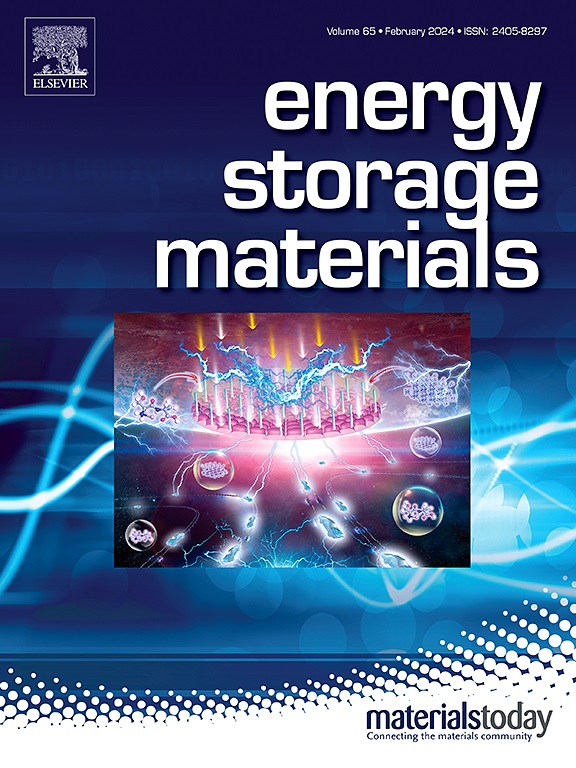Confined biomimetic catalysts boost LiNO3-free lithium-sulfur batteries via enhanced LiTFSI decomposition
IF 18.9
1区 材料科学
Q1 CHEMISTRY, PHYSICAL
引用次数: 0
Abstract
Lithium-sulfur batteries face a critical challenge
LiNO3 limits the electrochemical stability window of electrolyte and poses safety risks. This study presents FePC@NH2−MIL-68, a biomimetic enzyme catalyst stable in ether-based electrolytes, to address these issues, which can replace LiNO3 and facilitate Li-anion decomposition. Theoretical and spectroscopic investigations show it promotes LiTFSI decomposition, forms robust CEI and SEI interfaces, and enhances sulfur conversions. Consequently, the FePC@NH2−MIL-68 cell, without LiNO3 additive, delivers a high discharge capacity of 1549 mAh g−1 at 0.2 C and a low capacity decay rate of 0.067% over 1000 cycles at 1.5 C. Even under high sulfur loading of 7.9 mg cm−2 and low electrolyte-to-sulfur ratio of 5.5 μL mg−1, the cells maintain 720 mAh g−1. This work emphasizes that in developing sulfur conversion catalysts, special attention must be paid to their effects on other lithium salt components, which provides a guidance for new catalysts design for metal-sulfur batteries.


密闭仿生催化剂通过增强LiTFSI分解促进无lino3锂硫电池
锂硫电池面临着严峻的挑战,因为ino3限制了电解液的电化学稳定窗口,存在安全风险。本研究提出了一种在醚基电解质中稳定的仿生酶催化剂FePC@NH2-MIL-68来解决这些问题,它可以取代LiNO3并促进锂阴离子的分解。理论和光谱研究表明,它促进了LiTFSI分解,形成稳健的CEI和SEI界面,并提高了硫转化。结果表明,在不添加LiNO3的情况下,FePC@NH2-MIL-68电池在0.2℃下具有1549 mAh g−1的高放电容量,在1.5℃下具有0.067%的低衰减率,即使在高硫负荷为7.9 mg cm−2和低电解质硫比为5.5 μL mg−1的情况下,电池也能保持720 mAh g−1。本研究强调在开发硫转化催化剂时,必须特别注意其对其他锂盐组分的影响,为金属硫电池新型催化剂的设计提供指导。
本文章由计算机程序翻译,如有差异,请以英文原文为准。
求助全文
约1分钟内获得全文
求助全文
来源期刊

Energy Storage Materials
Materials Science-General Materials Science
CiteScore
33.00
自引率
5.90%
发文量
652
审稿时长
27 days
期刊介绍:
Energy Storage Materials is a global interdisciplinary journal dedicated to sharing scientific and technological advancements in materials and devices for advanced energy storage and related energy conversion, such as in metal-O2 batteries. The journal features comprehensive research articles, including full papers and short communications, as well as authoritative feature articles and reviews by leading experts in the field.
Energy Storage Materials covers a wide range of topics, including the synthesis, fabrication, structure, properties, performance, and technological applications of energy storage materials. Additionally, the journal explores strategies, policies, and developments in the field of energy storage materials and devices for sustainable energy.
Published papers are selected based on their scientific and technological significance, their ability to provide valuable new knowledge, and their relevance to the international research community.
 求助内容:
求助内容: 应助结果提醒方式:
应助结果提醒方式:


